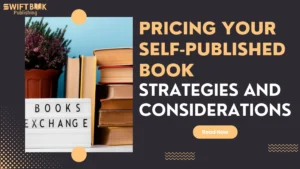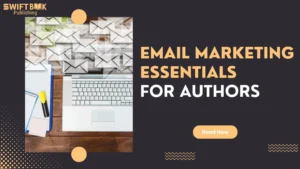You’ve written the book, sorted the cover, figured out distribution, now comes the part no one warns you about: getting people to actually talk about it. Yep, we’re talking reviews. Not just the “I liked it” kind, your mum might leave, but real feedback from readers that can help shift your book from invisible to irresistible.
Whether you’re self-published or traditionally published, using reader reviews marketing is one of the most overlooked tools in an author’s promotion strategy. When done right, it doesn’t just build trust, it builds buzz. So, let’s break down how you can encourage reviews, use them smartly in your marketing, and respond to them like a pro (even when they sting a bit).
Why Reader Reviews Matter More Than You Think
When was the last time you bought a book without checking the reviews first? Exactly. Readers trust other readers. Reviews offer social proof that your book is worth the time and money. They can also influence Swift rankings, fuel retailer algorithms, and play a massive role in whether someone hits “Buy Now” or keeps scrolling.
And if you’re working on your book pre-orders strategy, reviews can help boost visibility before the book is even out. Early feedback builds anticipation, especially if you’re planning a virtual book launch or running ads that lead to a sales page stacked with stars.
Encouraging Reviews Without Being Annoying
Getting reviews isn’t just about asking. It’s about asking well. Here’s how you can nudge readers without sounding desperate:
1. Use Your Back Matter
The end of your book is prime real estate. Include a friendly note asking readers to leave a review on Swift, Goodreads, or wherever they bought the book.
2. Email Your List
If you’re into email marketing for authors, this is your moment. After launch, send a reminder to your subscribers with a direct review link. Keep it short, sweet, and human.
3. Create a Street Team
A small group of loyal readers can help you generate reviews early on. Offer ARCs (advance review copies), shoutouts, or even bonus content to thank them.
4. Be Where Your Readers Are
Platforms like Goodreads for authors let you connect with early reviewers, join genre-specific groups, and build momentum before your official release.
Where to Use Those Glowing Reviews
Once you’ve got reviews, it’s time to let them work for you. Think of them as marketing ammo, not just feel-good comments.
- Feature them in your book media kit – Great for press, blogs, or podcasts.
- Use quotes in a book promotional video – Short quotes over dynamic visuals? Yes please.
- Add them to your author website – Especially for homepage banners or landing pages.
- Incorporate them in your email campaigns – Drop a line or two into your newsletter.
- Include them in your Swift A+ content – If you’ve got access, they make brilliant trust signals.
Reviews also pair nicely with your book translation publishing strategy. If your English book is already well-reviewed, it makes the foreign version more appealing to new audiences and retailers.
What to Do With Negative Reviews (Yep, They’ll Happen)
Negative reviews are inevitable. No book is for everyone, and that’s okay. What matters is how you respond (or don’t).
- Never argue – Ever. It’ll backfire faster than a bad blurb.
- Learn from patterns – If 10 people say your pacing is slow, there’s probably something to it.
- Use constructive criticism in future projects – Especially before you prepare a manuscript for an audiobook or update editions.
And if you’re unsure whether the review is fair, ask your editor. This is where copy editing vs proofreading feedback and professional input help separate noise from actual insight.
Building a Long-Term Review Strategy
A solid review strategy isn’t a one-time thing. It’s ongoing. If you’re working with book marketing services, they’ll likely include review outreach as part of your campaign. If not, here’s how to keep things moving:
- Offer free sample chapters in exchange for feedback
- Run Goodreads giveaways for exposure and reviews
- Keep an eye on the pricing of self-published book content. More affordable titles often attract more impulse buys and reviews.
- Ask for blurbs from authors in your niche. You can use those as endorsements in promotional material.
And don’t forget your launch team. Many authors keep the same reviewers across books. These relationships matter more than most writers realise.
Using Reviews to Strengthen Future Books
Reader feedback can directly influence your next title’s success. From improving pacing to spotting gaps in your research, reviews offer real-world insight. If you’re building your author brand seriously, it’s worth investing in things like:
- A stronger book typography tips review
- Better genre alignment, especially for translated versions
- Improved blurb writing for different territories
- A better way to write a query letter if you’re pitching to agents or publishers
And yes, refining your tone, flow, and narrative based on reader input can help immensely when you’re working on your next prepared manuscript for an audiobook version or visual content.
Final Note
If you’re serious about building momentum, using reader reviews marketing should be part of your core book strategy, not just something you hope happens on its own.
Reviews help you grow your audience, improve your writing, and promote your book authentically across platforms. Whether you’re planning a KDP Select vs a wide distribution strategy or gearing up to publish internationally, reviews are your readers’ way of saying, “This book matters.”
So encourage them. Use them. And when the five stars come rolling in, don’t just screenshot them, put them to work.
And if the whole process feels overwhelming? That’s where expert help comes in. From setting up a review campaign to planning a seamless virtual book launch, book marketing services can take the weight off your shoulders, so you can focus on writing the next one.







